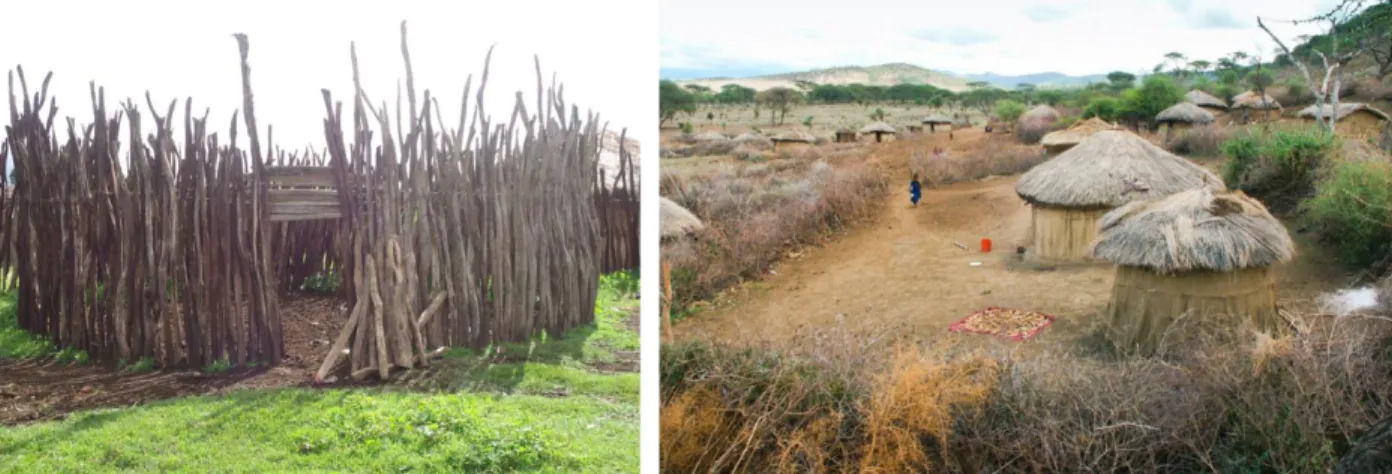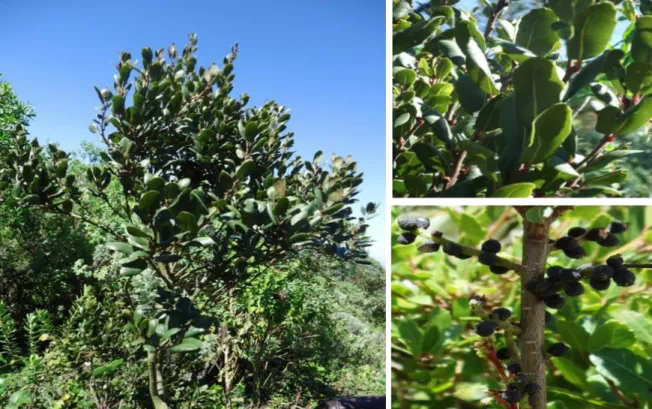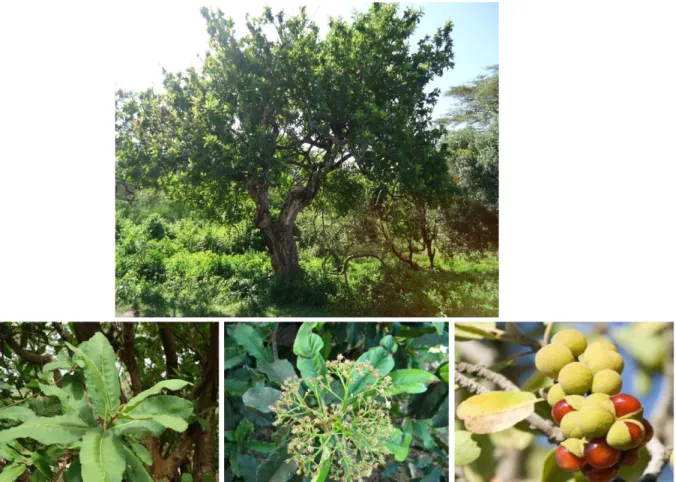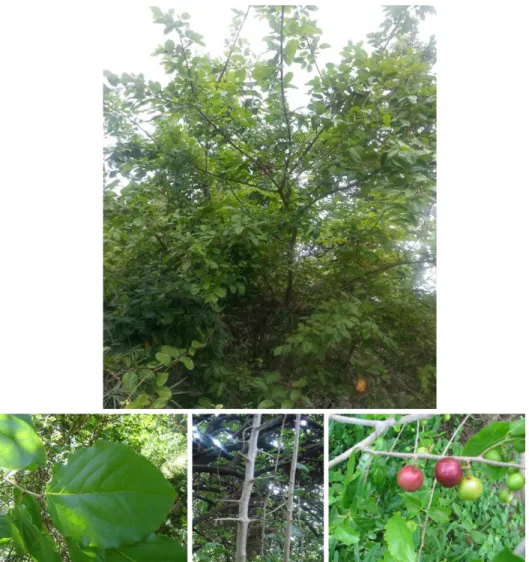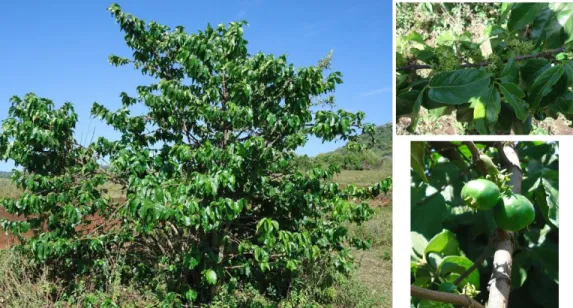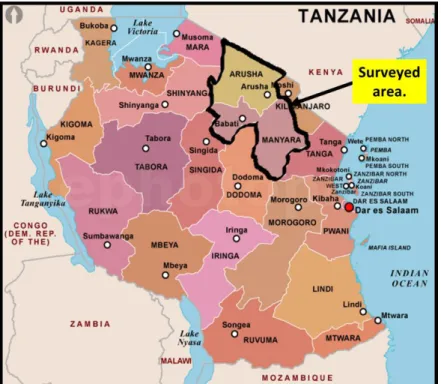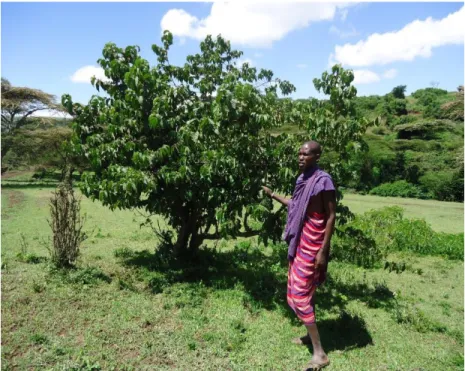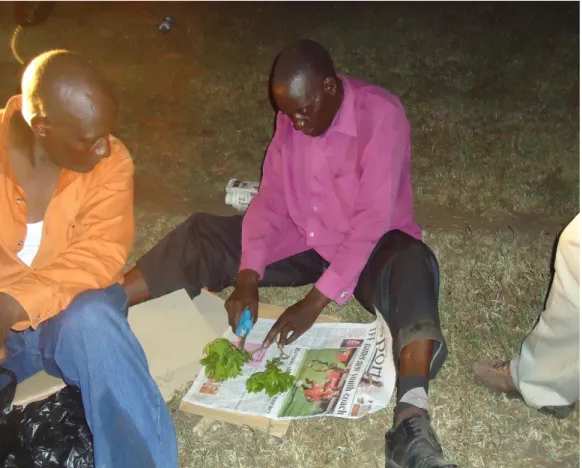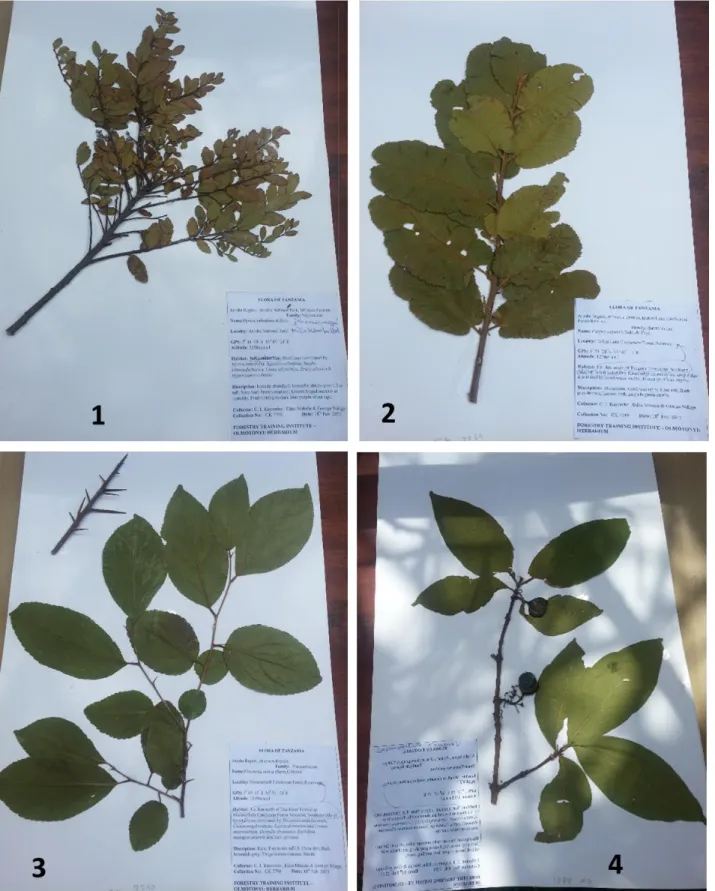Ethnopharmacological survey and phytochemical investigation of Maasai traditional medicinal plants
from north-eastern Tanzania
Dissertation
Submitted to the Faculty of Chemistry and Pharmacy, University of Regensburg for the degree of
Doctor of Natural Sciences (Dr. rer. nat.)
Presented by
Edna Makule
From Arusha, Tanzania2015
Gedruckt mit Unterstutzung des Deutschen Akademischen Austauschdienstes.
The present work was carried out from October, 2012 until November, 2015 under the supervision of Prof. Dr. Jörg Heilmann and Dr. Birgit Kraus at the Institute of Pharmacy, Faculty of Chemistry and Pharmacy, University of Regensburg.
Dissertation submitted on: 16. 11. 2015
Oral presentation on: 21. 12. 2015
Examination committee: PD Dr. Sabine Amslinger (Chairperson) Prof. Dr. Jörg Heilmann (First examiner) Prof. Dr. Ulrike Lindequist (Second examiner) Prof. Dr. Gerhard Franz (Third examiner)
giving me life and immense strength throughout the course of this PhD work. For him all things are possible.
I am sincerely grateful to my supervisor Prof. Dr. Jörg Heilmann, for having trust in me in the first place and giving me an opportunity to pursue my PhD studies under his supervision. His expertise, generous support, guidance, valuable ideas and suggestions, have made it possible for me to accomplish the work on the topic that was interesting for me.
My heartfelt gratitude to my co-supervisor Dr. Birgit Kraus, for her kind supervision, tireless guidance, encouragement, problems solving ability, valuable suggestions, constructive ideas throughout the time of my doctorial research. Besides, a friend to rely on. I am indebted to her more than she knows.
I am thankful to Dr. Guido Jürgenliemk for introducing me to the first analytics procedures, his willingness to help, advice, comments, corrections, as well as for providing tips and analytical tricks whenever I consulted him, were honored.
I would like to thank Mrs. Gabriele Brunner for her technical advice during the whole period of my lab work and tips for column chromatography.
I am thankful to all my colleagues, who have finished and those who are still pursuing the PhDs at the department of Pharmaceutical Biology - University of Regensburg: Dr. Sebastian Schmidt, Dr. Marcel Flemming, Dr. Daniel Bücherl, Dr. Rosmarie Scherübl, Dr. Petr Jirásek, Dr. Beata Kling, Dr. Tri Hieu Nguyen, Monika Untergehrer, Markus Löhr, Stefan Wiesneth, Eva Lotter, Ilya Volkov, Christian Zeh, Katharina Schiller, Julianna Ziegler, Sebastian Schwindl and Sina Malenke.
I appreciate their valuable help, technical discussions and mutual support which made my work in the lab smooth and enjoyable.
My sincere appreciations are extended to the following:
Mr. Fritz Kastner at the NMR department – University of Regensburg, for performing all the NMR measurements.
Mr. Josef Kiermaier at the Mass spectrometry department- University of Regensburg, for carrying out all mass spectra measurements.
Prof. Dr. Thomas Schmidt from the Institute of Pharmaceutical Biology and Phytochemistry – University of Münster, for carrying out CD calculations.
Mr. Daniel Sitoni from Tanzania National Herbarium, Arusha, and Mr. Canisius Kayombo from Olmotonyi Forestry Institute, Arusha, for a great assistance in plants identification during ethnopharmacological field work.
Mr. Victor Makundi for analyzing the GPS data recorded during ethnopharmacological field work and fixing them in the map.
I am grateful to the Ministry of Education and Vocational Training (MoEVT) - Tanzania and Deutscher Akademischer Austausch Dienst (DAAD) – Germany, for financial support that has enabled me to pursue and successfully complete PhD studies in Germany.
I am indebted to my employer Nelson Mandela African Institute of Science and Technology (NM-AIST), Arusha, for granting me a study leave and for financial support to carry out field work on ethnopharmacological survey.
My special thanks goes to my lovely children Irene Emily, Emmy Claire and Godlisten for having patience on me all the time I was not at home because of my studies. It is my prayer that you live to enjoy the outcomes.
I owe my loving thanks to my husband Mecku for his understanding, positive attitude, support, sacrifices and above all for taking care of the family without complaints all the time I was not at home. Without his great support and encouragements it would have been impossible for me to finish this work.
Lastly, and most importantly, I am indebted to my parents Edward and Felister for their unconditional love, prayers and for raising me to be the person I am today. May GOD bless you abundantly, grant you good health, happiness, peace, prosperity and long life.
Edna Makule
Regensburg - November, 2015
This thesis work is dedicated to:
1. My loving husband Mecku R. Kessy
For all the love, support, patience and words of encouragement. You have made this time a truly wonderful experience in my life. I can’t find words
to utter but to say, “Thank you for being so kind and loving”.
2. My beautiful girls Irene Emily & Emmy Claire
It was such a difficult moment for you being at home without Mama around. You could not clearly explain the feelings you had, but you kept
asking this question; Mama when are you coming back home? This question nailed my heart day and night. It also motivated me to work hard so that I can accomplish the goals and be with you again my sweet
angels.
1D One-dimensional 2D Two-dimensional
δ Chemical shift
J Coupling constant brs Broad singlet CD Circular dichroism COSY Correlated spectroscopy COX Cyclooxygenase
CPC Centrifugal partition chromatography
d Doublet
dd Doublet of doublet DCM Dichloromethane EtOAc Ethylacetate EtOH Ethanol
HCl Hydrochloric acid
HIV Human Immunodeficiency Virus
HMBC Heteronuclear multiple bond correlation
HP HPLC method
HPLC High performance liquid chromatography
HRESI-MS High resolution electron spray ionization-mass spectrometry HSQC Heteronuclear single quantum coherence
HTs Hydrolysable tannins
LC-MS Liquid chromatography-mass spectrometry
m Multiplets
MeCN Acetonitrile MeOH Methanol
MHz Megahertz
NMR Nuclear magnetic resonance
NOESY Nuclear overhauser enhancement spectroscopy NP-TLC Normal phase thin layer chromatography PAs Proanthocyanidins
PE Petrol ether extract ppm Parts per million Rf Retardation factor
ROESY Rotating-frame nuclear overhauser effect correlation spectroscopy rpm Revolutions per minute
s Singlet
SMB Per-O-(S)-2-methylbutyrate STDs Sexual transmitted diseases TFA Trifluoroacetic acid
TDDFT Time dependent density functional theory TLC Thin layer chromatography
TMP Traditional medicinal practitioner TNH Tanzania National Herbarium tR Retention time
UV Ultraviolet
1 General introduction ... 1
1.1 Traditional medicine in Tanzania ... 1
1.2 Aim of the research work ... 3
2 Ethnopharmacological survey of four Maasai traditional medicinal plants ... 4
2.1 The Maasai ... 4
2.1.1 Culture ... 4
2.1.2 Maasai and medicinal plants utilization... 7
2.2 Surveyed medicinal plants ... 8
2.2.1 Myrica salicifolia A. Rich. ... 8
2.2.1.1 Botany ... 8
2.2.1.2 Ethnomedicinal uses ... 9
2.2.1.3 Phytochemistry and biological activity ... 10
2.2.2 Pappea capensis Eckl. & Zeyh. ... 10
2.2.2.1 Botany ... 10
2.2.2.2 Ethnomedicinal uses ... 11
2.2.2.3 Phytochemistry and biological activity ... 12
2.2.3 Flacourtia indica (Burm. f.) Merr. ... 13
2.2.3.1 Botany ... 13
2.2.3.2 Ethnomedicinal uses ... 14
2.2.3.3 Phytochemistry and biological activity ... 15
2.2.4 Vangueria apiculata K. Schum. ... 16
2.2.4.1 Botany ... 16
2.2.4.2 Ethnomedicinal uses ... 17
2.2.4.3 Phytochemistry and biological activity ... 18
2.3 Description of the surveyed area ... 18
2.4 Methods ... 20
2.4.1 Informant selection ... 20
2.4.2 Interviews and data collection ... 20
2.4.3 Plant identification and preparation of herbarium specimens ... 23
2.5 Results ... 25
2.5.1 TMPs location and plants samples collection sites ... 25
2.5.2 Traditional description of the documented diseases ... 28
2.5.3 Medicinal uses of the selected plants ... 30
2.5.3.1 Myrica salicifolia ... 30
2.5.3.2 Pappea capensis ... 31
2.5.3.3 Flacourtia indica ... 31
2.5.3.4 Vangueria apiculata ... 32
2.5.3.5 Diseases reported to be treated by all four plants ... 33
2.5.4 Plant parts used and medicinal preparation ... 34
2.5.5 Drug administration and ethnopharmaceutical information ... 36
2.5.6 Traditional management of overdose symptoms ... 38
2.5.7 Other uses of the surveyed plants ... 38
2.6 Discussion ... 40
2.6.1 General observations from the survey ... 40
2.6.2 Preservation and transfer of traditional medicinal knowledge in the area ... 41
2.6.3 Medicinal plants conservation in the area ... 42
2.7 Conclusion ... 44
3 Phytochemical investigation of Myrica salicifolia A. Rich bark ... 45
3.1 Introduction and background ... 45
3.1.1 The genus Myrica ... 45
3.1.2 Phytochemical composition of the former genus Myrica... 47
3.1.2.1 Tannins ... 48
3.1.2.1.1 Tannins from Myrica sp. and their biological activities ... 51
3.1.2.2 Diarylheptanoids ... 56
3.1.2.2.1 Diarylheptanoids from Myrica sp. and their biological activities ... 57
3.1.2.3 Other groups of compounds from Myrica sp. ... 60
3.1.2.4 Phytochemical investigation and biological activities of Myrica salicifolia ... 61
3.2 Materials and Methods ... 62
3.2.1 Chemicals, solvents, reference sugars and enzyme... 62
3.2.2 Laboratory equipment ... 63
3.2.3 Other laboratory materials ... 65
3.2.4 Columns used for chromatography ... 65
3.2.5 Plant material ... 66
3.2.6 Extraction of plant material ... 68
3.2.7 Fractionation and isolation ... 69
3.2.7.1 Thin layer chromatography (TLC) ... 69
3.2.7.2 Sephadex® LH-20 fractionation ... 71
3.2.7.3 Flash chromatography ... 72
3.2.7.4 Semi preparative HPLC ... 73
3.2.7.5 Centrifugal partition chromatography (CPC) ... 75
3.2.8 Structure elucidation ... 76
3.2.8.1 NMR spectroscopy ... 76
3.2.8.2 Mass spectrometry ... 77
3.2.8.3 UV-VIS spectroscopy ... 77
3.2.8.4 Polarimetry... 78
3.2.8.5 Circular dichroism (CD) spectroscopy ... 78
3.2.8.6 Determination of type and absolute configuration of glycosides ... 79
3.2.8.7 Enzymatic deglycosydation of cyclic diarylheptanoid glycoside ... 80
3.2.8.8 CD spectra simulation ... 81
3.3 Results ... 82
3.3.1 Extraction and preliminary investigation of M. salifolia bark ... 82
3.3.2 Fractionation and chromatography of M. salicifolia bark crude methanolic extract ... 84
3.3.3 Fractionation and preparative isolation of tannins ... 85
3.3.3.1 Fraction S4... 85
3.3.3.2 Fraction S5... 86
3.3.3.3 Fraction S6... 88
3.3.3.4 Fraction S7... 89
3.3.4 Fractionation and preparative isolation of non-tannin compounds ... 91
3.3.4.1 Fraction S2.F4 ... 91
3.3.4.2 Fraction S2.F5 ... 93
3.3.4.3 Fraction S2.F6 ... 96
3.3.5 Structure elucidation of the isolated compounds ... 98
Determination of relative configuration of the isolated compounds ... 98
Absolute stereochemistry of the isolated compounds ... 100
3.3.5.1 Tannins ... 101
3.3.5.1.1 Proanthocyanidins ... 102
Monomeric flavan-3-ols ... 102
Dimeric B-type prodelphinidins ... 104
Dimeric A-type prodelphinidins ... 108
3.3.5.1.2 13C NMR analysis of polymeric PA fraction of M. salicifolia... 117
3.3.5.1.3 Ellagitannin ... 119
3.3.5.2 Cyclic diarylheptanoids ... 122
3.3.5.2.1 Determination of absolute configuration of isolated cyclic diarylheptanoids ... 123
Confirmation of the glycoside type and its absolute configuration ... 123
Absolute configuration of myricanol and other isolated diarylheptanoids ... 127
3.3.5.2.2 Cyclic diarylheptanoids without glycoside moiety ... 132
3.3.5.2.3 Cyclic diarylheptanoid monoglycosides ... 135
Compounds 13, 14 and 15 ... 135
Compound 16 ... 137
Compound 17 ... 141
Compound 18 ... 144
3.3.5.2.4 Galloylated cyclic diarylheptanoid glycosides ... 147
3.3.5.2.5 Cyclic diarylheptanoid di-glycosides ... 151
Compounds 22 and 23 ... 151
Compound 24 ... 156
Compounds 25 and 26 ... 159
3.3.5.3 Methylated ellagic acid glycosides (MEAG) ... 162
Compound 27 ... 163
Compounds 28 and 29 ... 166
3.3.5.4 Further compounds ... 169
Compound 30 ... 169
Compound 31 ... 171
3.4 Summary and discussion of the isolated compounds from M. salicifolia bark ... 174
3.4.1 Summary on the isolated compounds ... 174
3.4.2 Determination of absolute configuration of isolated diarylheptanoids ... 177
3.4.3 Comparison of isolated compounds from M. salicifolia and other plant species ... 180
3.4.3.1 Tannins ... 180
3.4.3.2 Cyclic diarylheptanoids ... 180
3.4.3.3 Methylated ellagic acid glycosides (MEAG) ... 181
3.5 Conclusion ... 185
4 Summary and future recommendation ... 186
5 References ... 189
6 Appendix ... 203
6.1 Plant samples and voucher specimen collection sites ... 203
6.2 Location of the interviewed TMPs ... 204
6.3 Reported medicinal uses of the four plants ... 207
6.4 Plant parts used ... 208
6.5 Plants collection and storage, remedies preparations, dosage, application form and application time……….. 209
1
1 General introduction
1.1 Traditional medicine in Tanzania
Tanzania is a relative large country with a total area of 945,087 square kilometres, which is located in the eastern part of the African continent. Tanzania’s population is estimated to be about 45 million people as per national census of 20121, whereby about 35 million (69.1%) of the people live in rural areas. Approximately 68% of the population live below the poverty line of $1.25 a day and 90% of the poor population live in the rural areas2,3. Despite the existing poverty in the country, Tanzania is endowed with a great abundance of floral diversity which is estimated to constitute about 12,667 plant species of which 1122 are endemic. About 10% of the plant species are reported to be used for traditional medicinal purpose4,5.
Traditional medicinal practices are a vital component of healthcare in Tanzania. Although the modern health care is increasing, more than 60% of Tanzania’s population and actually 80% of the rural people rely on traditional medicine as their primary health care6,7. In the year 2000, there were about 80,000 traditional medicinal practitioners (TMPs) and 1,500 doctors in the country, giving a ratio of TMP to patients of 1:400 while the ratio for medical doctors to patients was 1:30,0004,8,9 . This clearly describes the better access to traditional medicine as compared to the modern healthcare. Additional reasons for the high dependency on traditional medicine are the existing poverty, cultural conservatism, lack of reliable and affordable conventional health care services4,6,10.
The traditional medicinal system in Tanzania is characterized by two categories of disease aetiology namely natural and supernatural causes11. Natural causes of sickness include such as cold, heat, infections and imbalance in the basic body elements. Supernatural causes of illnesses are mainly witchcraft and spiritual causes resulting from penalties incurred for sins and breaking taboos. The most prevalent natural diseases which often cause the reason for seeking medical attention are parasitic diseases such as malaria and intestinal worms; diseases caused by bacterial infections due to inadequate potable water and poor hygienic conditions such as cholera, typhoid, acute respiratory infections, pneumonia, skin and eye infections, diarrhoeal
2
diseases and others such as anaemia, perinatal conditions and tuberculosis to mention a few12,13.
TMPs cures the natural caused diseases mostly by using medicinal plants. Medicinal plants are available throughout the year. Furthermore, they are easily accessed by people who have limited contact to modern health services and by low income earners who are equipped with the curative knowledge of the particular plants14. In Tanzania, traditional medicinal knowledge and practices have been passed on mainly orally among people as well as TMPs from one generation to another. In some cases the medicinal knowledge remains the secret to the particular TMP until the old age, not till then he/she passes on the knowledge to a selected member of the family. If the TMP encounters sudden death, the knowledge gets lost.
Despite the great abundance of medicinal plants in Tanzania, their curative effectiveness and applicability by a large population, traditional medicine practices are threatened by a lack of reliable documentation which has made its promotion difficult within the country.
Furthermore, medicines derived from plants are currently only limited regulated. There is no national pharmacopoeia, no monographs and no safety assessments to demonstrate harmful effects of these medicines7. There is also no restriction for selling traditional medicine in the market which as well threatens the biodiversity7.
Regulatory effort to promote and standardize traditional medicine in Tanzania is underway. In 1974, the government established the Traditional Medicine Research Unit as part of the University of Dar es Salaam and the Muhimbili Medical Centre15,16. In 1991, the name of the unit was changed to Institute of Traditional Medicine which is now located in Muhimbili University of Health and Allied Sciences. The Institute is responsible for research on traditional healing systems in Tanzania, to identify useful practices which can be adopted, modernized and developed into drugs for use to improve human health. Furthermore, the Institute is carrying out clinical observations and toxicological studies as a means to promote safe products and identifying and discouraging harmful products. Additionally, it is intending to promote trade in herbal medicines, as a way to contribute to national growth and poverty reduction. The Institute is also planning to promote community based cultivation of medicinal plants and the sale of their extracts and possibly isolated pure compounds within the country and abroad
3
which in the future will promote commerce in medicinal plants and, therefore, become a source of income for the people.
1.2 Aim of the research work
Tanzania has more than 120 ethnic groups which hold immense knowledge on traditional medicinal practices serving on healing several human ailments. Among Tanzania’s ethnic groups the Maasai are renowned for their traditional medicinal practices and they greatly rely on medicinal plants17,18. Maasai consume medicinal plants as part of their diet in form of herbal soup, tea, tonic, decoction and infusion19. Among the common and frequently utilized medicinal plants in their area are e.g. Myrica salicifolia, Pappea capensis, Flacourtia indica and Vangueria apiculata. Despite the frequent utilization of these plants and its alleged medicinal potent, reliable documentation on their traditional medicinal use, drug preparation, ethnopharmaceutical information, phytochemical composition and pharmacological characterization to prove their medicinal efficacy are scarce.
Therefore the aim of this research work was, to conduct a detailed survey and document information on Maasai traditional medicinal use of these four medicinal plants in Arusha and Manyara regions, north-eastern Tanzania.
In addition to the ethnopharmacological study, plant material should be collected to allow subsequent phytochemical characterization of the plants. Following, phytochemical characterization of M. salicifolia bark should be done to identify potential active compounds that could be responsible for documented activity and usage of the drug.
4
2 Ethnopharmacological survey of four Maasai traditional medicinal plants
Ethnopharmacological survey is a common and crucial method which involves inquiring and gathering information on healing abilities of traditional medicines within one or different ethnic groups. It is a tool for preserving indigenous traditional medicinal knowledge for future generation. Furthermore, ethnopharmacological survey paves a way to scientific investigation, proof and validation of the gathered information through phytochemical and pharmacological characterization, hence complementing to drugs discovery by pharmaceutical industry20. In this study ethnopharmacological survey of four Maasai medicinal plants was conducted in Manyara and Arusha regions of the north-eastern Tanzania.
2.1 The Maasai
2.1.1 Culture
Maasai is an ethnic group residing in the north-eastern area of Tanzania extending up to the south area of Kenya. They originate from the Nilotic people indigenous to the Nile valley in the north of Africa who came to southeast Africa through the way of South Sudan. Maasai is a linguistic term, referring to speakers of the Eastern Sudanic language (Maa) of the Nilo-Saharan family19. Maasai are a pastoral people, herding cattle, sheep and goats, and sometimes donkeys as their source of income and wealthy symbol21,22. Unlike many other ethnic groups in Tanzania, Maasai have managed to maintain most of their traditional life style and by doing so they have become famous touristic attraction. Maasai are semi nomadic people who have no fixed homes and move from one place to another with cattle in searching for pasture. Maasai nomadic life has permitted them to have access to various biological resources, which has contributed to an enormous traditional knowledge on their landscape21,23.
Generally, Maasai are divided into sixteen tribe sections with differences in customs, appearance, leadership and dialects. These sections are known as the Keekonyokie, Loodokolani, Purko, Wuasinkishu, Matapato, Laitayiok, Loitai, Damat, Dalalekutuk, Kisonko,
5
Kaputiei, Kankere, Lmoitanik, Loitokitoki, Larusa, and Sikirari. The sections residing in the north- eastern area of Tanzania are the Loitai, Kisonko and Larusa section19,21,23.
In addition to tribe sections, Maasai are characterized by age groups which is the basic political and social structure is their rigid system. The age set is primarily applied to the men, women become members of the age set through their husbands. Every five to seven years, a new age group of the young generation of about 14 years old is initiated into adult life through circumcision. The group formed is given a name and lasts throughout the life for its members.
The oldest groups which were existing in north-eastern Tanzania by the time the survey was conducted were Makaa and Landisi while the youngest groups were Korianga and Nyangulo (Morans - the junior warriors).
The Maasai live in small circular houses which are loosely constructed (Kraals) and fenced with acacia thorns or long strong poles to prevent lions from attacking their cattle21,22 (Figure 2.1).
The houses do not have windows and contain only one small door. Inside the house a skin of an animal (normally a cow skin) is placed on the ground for warmth. Their houses are always smoky and dark due to their habit of cooking inside the house using firewood. In the Maasai community, women are responsible for constructing houses using mud, grass, wood and cow dung, while men are responsible for making the fence. Habitually, Maasai live with extended families in the kraals21.
Other peculiar characteristics of the Maasai include the application of red ochre to their bodies (Figure 2.2), the long hair worn by the Morans (junior warriors), ear piercing and the stretching of earlobes, the coils of wire worn on the limbs of the women, the loads of beaded jewellery placed around the neck and arms and their colourful tradition sheets (shuka) wrapped around the body. The shuka is worn by both men and women and varies in colour depending on the occasion.
Traditionally, Maasai depends on their animals for food such as milk, meat, animal blood, honey, plants barks and leaves. In recent days they have begun to consume other foods like maize meal beans, rice, potatoes and others19.
6
Figure 2.1: Maasai houses. Left: Fence of long poles. Right: Small round houses fenced with acacia thorns.
Figure 2.2: Maasai clothing and decorations. Left: Moran worn long hair, stretched earlobes and smeared with red ochre (www. sneezr.ca. 05.10.2015). Right - up: Maasai women with shuka and beads decoration (www.gettyimages.com. 06.10.2015). Right - low: Morans with shuka and beads decorations (www.reuters.com.
06.10.2015).
7 2.1.2 Maasai and medicinal plants utilization
Maasai have been utilizing medicinal plants for years and they are deep-rooted in their life. The dependency on medicinal plants is contributed by the immense knowledge they have on nature and also by their life in the isolated remote areas where by modern health care is inaccessible and unavailable, just like other pastoral areas of East Africa. However, this knowledge is declining due to changes towards a more western lifestyle, overgrazing and over exploitation of plant resources have already led to a decline of the plant material available18.
At their early stage of life children are taught about the medicinal value of herbs21,24. Traditionally, it is the duty of Maasai young boys to look after small goats and sheep around their homes. During this process, they also learn about medicinal plants which are used at home. Maasai young boys and the Morans are further trained on medicinal knowledge during their tradition meat eating festival and healing retreat (Orpul). In the Orpul festival, apart from meat eating, meditation, remembrance of ancestor spirits and celebration, young boys and Morans are detailed trained on which medicinal plants are used for the treatments of common ailments so that primary health care is provided at the household level25. In another side, young Maasai girls obtained their knowledge of medicinal plants from their mothers and grandmothers, with whom they spend a lot of time18,23.
Maasai utilize herbs when they are healthy as well as in sickness situation. In a healthy condition, Maasai consume boiled herbal mixtures of bark and roots in soup for improving conditions of the stomach and the blood. Additionally, herbal mixtures are used by Morans preparing for attacks. For example, the Pappea capensis Eckl. & Zeyh (Sapindaceae) and Acacia nilotica (L.) Willd. ex Del. (Fabaceae) are taken as a digestive, excitant, for prevention of hunger and thirst. They are also known for preventing fatigue and fear in the wilderness18,26.
During sickness, Maasai use herbal remedies derived from trees and shrubs for curing minor ailments in their home. Some of the diseases treated at home are such as: malaria 18,23, gonorrhea and other sexual transmitted diseases, stomach infections18,23,27, painful joints, pregnancy disorders, tooth problems, eye infections19, colds and throat infections18,28,29 to mention a few. However, for persistent and chronic sicknesses, they seek for professional TMPS
8
consultations23. From the medicinal knowledge they possess, one medicinal plant can be used for the treatment of more than one diseases.
2.2 Surveyed medicinal plants
The survey should include plants which are prevalent in the area and are commonly used for the treatment of diseases by the Maasai. On this basis, four plants were selected, including Myrica salicifolia, Pappea capensis, Flacourtia indica and Vangueria apiculata.
Although preparations of the selected medicinal plants are frequently applied, documentation about ethnomedicinal uses, traditional preparation methods, dose administration, contraindications and overdose control methods within the area is scarce. Additionally, there is only little or no scientific data about phytochemistry of these plants nor any reliable scientific investigation about active compounds, bioactivity and healing potential.
2.2.1 Myrica salicifolia A. Rich.
2.2.1.1 Botany
Myrica salicifolia A. Rich. is also known as Olkitalaswa (Maasai). It belongs to the family Myricaceae of the order Fagales and the former genus Myrica. The genus was divided into two genera: Myrica and Morella where by M. salicifolia is now belonging to the genus Morella as detailed described in chapter 3 section 3.1.1. The former species name of Myrica salicifolia will be used in this study.
M. salicifolia may grow like a shrub or a tree of up to a height of 12 m30,31 (Figure 2.3 Left). The leaves of M. salicifolia are shiny, pale green when young and turn to tinged maroon when mature (Figure 2.3 Right - up). They are simple, irregularly serrated and arranged in alternate manner31. The bark of M. salicifolia is brown-maroon in colour. The flowers are small and very densely, yellow, fragrant and dotted with oil glands, male and female are separate32. The fruits of M. salicifolia are crowded small (2 - 4 mm) drupes in nature turning to dark blue purple when ripe (Figure 2.3 Right - down). M. salicifolia is reported to be spread in many mountainous ranges in Tanzania above 1,200 m high and prefers shallow soil, heath and rocky areas32. The
9
species is distributed mainly in Tanzania, Kenya, Uganda, Rwanda, Burundi, Ethiopia, DR Congo, Yemen and Saudi Arabia30,32.
Figure 2.3: Left: A small tree of M. salicifolia at Ngorongoro conservation area. Right - up: M. salicifolia leaves.
Right - down: Fruits of M. salicifolia at Miriakamba area, Arusha National Park.
2.2.1.2 Ethnomedicinal uses
Traditional medicinal use of M. salicifolia has been previously reported in Tanga – Tanzania. The decoction of the M. salicifolia leaves mixed with other plants leaves are used for treatment of swellings on the cheek and face. The powdered, dry stem bark of M. salicifolia is mixed with honey and eaten against cough. The bark of M. salicifolia is chewed to cure toothache.
Decoction of the bark is mixed with milk and given to children as a tonic. Roots are used as a slow acting medicine in stomach troubles and for headaches. Pounded young leaves are mixed with ghee and rubbed on skin diseases33. Additionally, in Bukoba, Tanzania, infusion and decoction of M. salicifolia bark and/or root are used for the treatment of HIV/AIDS opportunistic diseases such as tuberculosis, chronic diarrhoea, cryptococcal meningitis, and herpes simplex34.
10
In Ethiopia, pulverized young leaves of M. salicifolia are mixed with butter and used externally to treat skin diseases35. In Western Uganda, oral consumption of boiled pounded roots and barks of M. salicifolia has been used for the treatment of men sexual impotence and erectile dysfunction36.
2.2.1.3 Phytochemistry and biological activity
Geyid et al.37 conducted a phytochemical screening on methanolic extracts of stem bark and leaves of M. salicifolia and discovered the presence of polyphenols, unsaturated sterols/triterpenes, saponins, glycosides and carbohydrates. Furthermore, these authors found that a methanolic extract of M. salicifolia stem bark at high doses of 2 mg/mL was effective against Bacillus cereus, Neisseria gonorrhoeae, Shigella dysenteriae and Staphylococcus aureus.
Njung’e et al.38 carried out an in-vivo testing of a methanolic extract of M. salicifolia on laboratory mice regarding its analgesic, antipyretic and anti-inflammatory activity. They discovered that M. salicifolia methanolic extract exhibited potent analgesic and antipyretic activity at a concentration of 100 mg/kg.
2.2.2 Pappea capensis Eckl. & Zeyh.
2.2.2.1 Botany
Pappea capensis Eckl. & Zeyh., also known as Oltimigomi (Maasai), mbamba ngoma (Swahili), jacket plum (English), belongs to the family Sapindaceae in the order Sapindales. It is a long- lived, hardy, evergreen, small to medium tree with a height of 2 - 8 m but occasionally exceeds 12 m, with a dense, rounded crown32 (Figure 2.4 Up). P. capensis grows in open and grassy woodland, rocky outcrops and brackish flat areas, sometimes in the bush close to rivers or dry river vicinities39. The leaves of P. capensis are alternate, simple, oblong, hard-textured and wavy. They are crowded at the ends of the branches as shown in Figure 2.4 Left - down. The leaf margin changes from sharply toothed in young leaves to almost smooth in mature leaves.
The leaves are paler green below, wavy, rough and leathery. P. capensis has small greenish or pale yellow flowers in spikes to 12 cm, male are located at the end and female at the base of the spike32 (Figure 2.4 Middle – down). The bark is grey-brown in colour. The fruits of P.
11
capensis are furry green capsules, round and velvety. They have a diameter of over 1 cm. When the fruits ripe they split open to expose a bright red flesh containing a brown seed32 (Figure 2.4 Right - down). P. capensis is drought resistant and adapts to wide temperature variations32,39. The species is mainly found in Tanzania Namibia, Botswana, Swaziland Mozambique, Zimbabwe, Zambia, Malawi, Kenya, DR Congo, Ethiopia, Eritrea and South Africa32.
Figure 2.4: Up: P. capensis tree at Ngorongoro conservation area. Left - down: P. capensis leaves. Middle - down:
Flowers of P. capensis (www.kumbulanursery.za). Right - down: P. capensis fruits (http://www.wildcard.co.za).
2.2.2.2 Ethnomedicinal uses
Ethnomedicinal use of P. capensis has been previously reported from other areas of Tanzania and Africa. In Morogoro region - Tanzania, P. capensis is used for treatment of aches and pains40. In Bukoba region, decoction of P. capensis leaves is used for treating chicken pox and back aches41.
12
In Kenya, infusion taken from roots, stem and bark of P. capensis is used for the treatment of chronic joints pain in Machakos and Makueni area27. It is also documented that bark or leaves decoction is taken with soup to treat stomach problems and diarrhoea28,29. Kiringe18 reported that bark of P. capensis boiled in water and then sieved. The mixture is taken for arthritis treatment. Furthermore, roots of P. capensis boiled in water and thereafter mixed with soup are used for the treatment of appetite loss and reduced body strength by Morans of Kaijiado18. An oral application of P. capensis bark decoction for the treatment of post-partum haemorrhage is documented in Machakos district42. Further use of P. capensis roots decoction is reported in Machakos for the treatment of morning sickness, typhoid, amoebic dysentery and abdominal pains43. In South Africa, oil extracted from the seeds, bark, leaves and roots of P.
capensis are used for the treatment of ringworm and baldness, venereal diseases, chest complaints, sore eyes and constipation44. Moreover, leaves of P. capensis are used for the treatment of venereal diseases, painful eyes and as aphrodisiac45.
2.2.2.3 Phytochemistry and biological activity
Phytochemical data and information about the pharmacological activity of P. capensis are scarce. A phytochemical screening of P. capensis leaves revealed the presence of phenolics, flavonoids, gallotannins and condensed tannins45.
Dichloromethane (DCM) and petrol ether (PE) extracts of P. capensis leaves were found to have good anti-inflammatory activity by inhibition of both cyclooxygenases 1 and 2 (COX-1 and COX- 2). In addition, methanolic and water extracts of P. capensis leaves exhibited good anti-HIV-1 reverse transcriptase activity. DCM, PE, ethanol and water extracts of P. capensis leaves also exhibited moderate to high antimicrobial activities against Neisseria gonorrhoeae, Bacillus subtilis, Escherichia coli, Klebsiella pneumoniae, Staphylococcus aureus and Candida albicans.
Literature data describing the detailed phytochemical composition and pharmacological activity of P. capensis barks and roots are not existing to date.
13 2.2.3 Flacourtia indica (Burm. f.) Merr.
2.2.3.1 Botany
Flacourtia indica (Burm. f.) Merr. Also known as alaimoronyai (Maasai), mchongoma or mugovigovi (Swahili), governor’s plum (English). It belongs to the genus Flacourtia, family Salicaceae and the order Malpighiales. F. indica is a deciduous tree or a bushy shrub often grows up to 7 m and sometimes up to 15 m maximum46 (Figure 2.5 Up). It is armed with axillary thorns and with tufts of branched thorns on the stem (Figure 2.5 Middle - down). The bark of F.
indica is usually pale, grey, powdery, may become brown to dark grey and flaking, revealing pale orange patches. Leaves are red or pink when young, variable in size, oval to round in shape, they are leathery and have toothed edge, contain 4 - 7 pairs of veins clear on both surfaces32 (Figure 2.5 Left - down). Flowers are small, cream, and fragrant. Male flowers with very many yellow stamens, female flowers with a divided spreading style32,46. Fruits are globular, reddish to reddish-black or purple when ripe, fleshy, up to 2.5 cm across, contained up to 10 brown flattened, wrinkled seeds (Figure 2.5 Right - down). F. indica grows naturally in dry forest, woodland, bushland, thickets and in the wooded grassland. The species is drought resistant, prefer full sun for best growth but can tolerate light shading. It is found throughout Tanzania46. F. indica is distributed worldwide in the following countries: Botswana, Burundi, Cameroon, Democratic Republic of Congo, Eritrea, Ethiopia, India, Kenya, Malawi, Namibia, Nigeria, Rwanda, Sierra Leone, Cuba, Dominica, South Africa, Tanzania, Uganda, Zambia, Zanzibar, Zimbabwe, Exotic :Antigua and Barbuda, Barbados, China, Dominican Republic, Grenada, Indonesia, Jamaica, Madagascar, Malaysia, Puerto Rico, Seychelles, Sri Lanka, St Kitts and Nevis, St Lucia, St Vincent and the Grenadines, Trinidad and Tobago, Virgin Islands of United States32.
14
Figure 2.5: Up: F. indica tree at kikavu area, Kilimanjaro. Left - down: F. indica leaves. Middle - down: Thorns of F.
indica. Right - down: F. indica fruits (http://www.especies-seeds).
2.2.3.2 Ethnomedicinal uses
In other areas of Tanzania fruits of F. indica are used for treatment of jaundice and enlarged spleens. Decoction of leaves and roots are taken for the treatment of schistosomiasis, malaria, and diarrhoea. Further to this, roots are used for hoarseness, pain reliever, diuretic, pneumonia, intestinal worms and as an astringent 46.
The Lobedu tribe of South Africa takes decoction of root for relief of body pain. Leaves are used as expectorant for asthma, pain relievers, treatment of gynaecological complaints, pneumonia and ring worms47.
In India and Bangladesh, fruits are used for treatment of jaundice and enlarged spleen, barks are used for the treatment of intermittent fever, roots are applied for treating nephritic colic
15
and gum is used in cholera treatment48. Additionally, bark infusion is suitable as a gargle for hoarseness, and roots are used in treatment of skin diseases, pruritus, nephropathy and scabies. Gum is administered along with other ingredients in cholera. Ground seeds mixed with turmeric and dried ginger is applied in form of a paste on woman body to reduce body pain after delivery48–50.
In Madagascar, the bark is triturated in oil and used as anti-rheumatic liniment, the root and ash have been used as remedy for kidney complaints47.
2.2.3.3 Phytochemistry and biological activity
Phytochemical screening of a methanolic and aqueous extracts of F. indica revealed the presence of steroids, alkaloids, tannins, saponins, flavonoids, glycosides, phenolic compounds and terpenoids51. Individual structures that were isolated and elucidated from F. indica include flacourtin - a phenolic glucoside ester52, pyrocatechol, homaloside D and poliothrysoside53, mururin A, coumarin, scoparone and aesculetin54 (Figure 2.6).
Previous literature reports on biological activity of F. indica in several in-vivo and in-vitro testing. In-vitro antioxidant activity of a methanolic and aqueous extract of F. indica leaves was evaluated by Tyagi et al.51. They showed, that the two extracts possess potent free radical scavenging and antioxidant activity at a concentration of 18 µg/mL. The same group investigated the in-vivo anti-asthma activity of the same extract on histamine-induced bronchospasm in guinea pigs, and reported that the extract was effective in reducing the symptoms of bronchial asthma and also improved the lung function parameters of asthmatic subjects55. Kaou et al.53 analysed the anti-malaria activity of the compounds isolated from the aerial part of F. indica, i.e. pyrocatechol, homaloside D and poliothrysoside, and discovered that poliothrysoside had three times higher activity against the chloroquine-resistant strain of Plasmodium falciparum type W2 as compared to pyrocatechol and homaloside D.
16
Figure 2.6: Compounds isolated from F. indica. 1: pyrocatechol, 2: aesculetin, 3: scoparone, 4: coumarin, 5:
mururin A, 6: homaloside D, 7: poliothrysoside, 8: flacourtin.
2.2.4 Vangueria apiculata K. Schum.
2.2.4.1 Botany
Vangueria apiculata K. Schum., belongs to the family Rubiaceae and the order Gentianales. It is also known as Olgumi (Maasai) and Mviru (Swahili)56. V. apiculata is a deciduous shrub or small spreading tree 1.8 - 15 m tall57,58 (Figure 2.7: Left). It has several stems which often branch horizontally. Leaves are opposite, elliptic oblong, ovate to lanceolate, up to 17 cm long, distinctly acuminate at the apex, glossy green, mostly hairless but sometimes finely pubescent beneath. The margin is entire but wavy; petioles are 0.5 - 1.5 cm long (Figure 2.7: Right - up).
The bark is greyish-brown to reddish-brown, smooth or finely ridged. Flowers are greenish- white, up to 1 cm in diameter with a conspicuous tuft of fine white hairs in the throat of the corolla. They are found in lax to dense untidy axillary heads. Fruits of V. apiculata are subglobose, sometimes asymmetric, 1.5 - 2.5 cm in diameter, green to brown, hairless when ripe (Figure 2.7: Right - down). They grow in a riverine thicket, evergreen forest, open
17
woodland and montane grassland, often among rocks. The plant is very adaptable, tolerates some drought and a wide range of soils57–59. V. apiculata is reported to be found in tropical countries of Africa such as Tanzania, Sudan, Ethiopia, Rwanda, eastern DR Congo, Uganda, Kenya, Malawi, Mozambique, Zambia and Zimbabwe57,59.
Figure 2.7: Left: V. apiculata tree at Monduli district. Right - up: V. apiculata leaves and flowers. Right - down: V.
apiculata unripe fruits.
2.2.4.2 Ethnomedicinal uses
In north-western Tanzania, the Haya tribe use decoction made from V. apiculata leaves for the treatment of diabetes60.
In Uganda, decoction of V. apiculata leaves is drunk for the treatment of constipation 61. Boiled decoction of V. apiculata roots is drunk three times a day for the treatment of intestinal worms62,63. Oral consumption of V. apiculata root juice is used for the induction of labour during child birth64.
In east Africa, leaves of V. apiculata are chewed and juice is swallowed for treatment of stomach ache. Leaf infusion is drunk for the treatment of body swelling and warts. Burned stem ash are licked for the treatment of tuberculosis62.
18 2.2.4.3 Phytochemistry and biological activity
Despite their alleged traditional medicinal effectiveness, there is no previous reported study on biological activity and chemical constituents of V. apiculata.
2.3 Description of the surveyed area
The ethnopharmacological survey was conducted in Arusha and Manyara regions located at the corner of north-eastern Tanzania between latitudes 2.07235 S and 5.39669 S south of the equator, longitudes 35.48332E and 37.4818E east of prime meridian (Figure 2.8). The area is bordered to Kenya in the north; Kilimanjaro and Tanga region in the east; Dodoma in the south;
Singida, Shinyanga and Mara region in the east. The area is estimated to be 82,428.5 km2 whereby 3,571 km2 (4.3%) is covered by water bodies and 78,857.5 km2 is land area. The water bodies in the area include Lake Eyasi, Lake Manyara, Lake Babati and Lake Natron. The population of the area is estimated to be about 3.1 million inhabitants as per Tanzania national census of 20121, with about 1.7 million people living in Arusha and about 1.4 million people in Manyara region respectively.
Administratively, the area is divided into eleven districts: Karatu, Arusha, Arumeru Monduli, Longido and Ngorongoro in Arusha region; Babati, Simanjiro, Kiteto, Hanang and Mbulu in Manyara region.
Several ethnic groups are found in the area with the Maasai being the main tribe in Kiteto, Simanjiro, Monduli and Ngorongoro. The Iraqw tribe is mainly found in Mbulu, Babati, Karatu and Hanang districts. The Meru and Arusha tribes are dominating the Arumeru and Arusha Municipality. Furthermore, the small tribes of Barbaig, Sonjo and Hadzabe (Tindiga) form a minority group which depends on hunting for livelihood. They are located in Hanang and Ngorongoro districts65.
Altitudinal range of the area is estimated to range between 900 and 1,600 m (3,000 - 5,200 ft.) in elevation above sea level. The vast altitudinal ranges have contributed to non-uniformity of climatic conditions. The area experiences temperatures between 25 - 31οC during the hottest season (November - February) and 13 – 20 οC in the coldest season (May - August).
19
Furthermore, the average annual temperature in the highland areas is estimated to be 21 οC and 24 οC in the lowlands65.
Concerning the rainfall, the area is classified as a dry and semi-dry area, with a noticeable dry season and a rainy season.Two types of rainfall patterns exist in the area; the monomodal and bimodal rainfalls. Monomodal rainfalls are experienced from November to April with an average annual rainfall range of about 800 - 1000 mm. This occurs in the southern part of the area which includes the districts of Babati, Hanang, Kiteto, Mbulu and Karatu. This type of rainfall is generally reliable and has made these districts to be the major cereal crops producers of the area. The remaining districts of Ngorongoro, Simanjiro, Arusha, Arumeru, Longido and Monduli experience bimodal rainfalls, which are characterized by both a short and a long rain period with an annual average precipitation of 1000 - 1200 mm. The short rains normally occur from October to December, while the long rains last from February to June. The whole area experiences a dry season between July and October65.
The vegetation of the area is characterized by savannah with high floral diversity. It can be divided into four natural vegetation zones, namely wooded bushlands, wooded grasslands, bushed grasslands and open grasslands. The latter is estimated to cover 80% of the area.
Figure 2.8: Map of Tanzania showing the location of the surveyed area (www.mapsofworld.com - 28.09.2015).
20
2.4 Methods
2.4.1 Informant selection
Informant selection was achieved through purposive sampling based on knowledge and practices on traditional medicine. Village Executive Officers were involved in obtaining a list of highly experienced traditional medicinal practitioners (TMPs) in a particular village and also identifying those who use medicinal plants for treatment without witchcrafts. Thereafter, identified TMPs were well informed about the study and requested for their participation consent. Then appointments for the interviews were planned prior the interview session. In this study, 65 TMPs (36 male, 29 female) aged between 50 - 75 years were selected and interviewed. Selected TMPs acquired the knowledge from their forefathers and mothers. The interviewed TMPS were residing in different villages of the four districts of Arusha (Monduli and Ngorongoro) and Manyara (Simanjiro and Kiteto) regions.
2.4.2 Interviews and data collection
Interviews with TMPs and ethnopharmacological data collection about the four medicinal plants Myrica salicifolia, Pappea capensis, Flacourtia indica and Vangueria apiculata was carried out from January to March, 2013. The interviews were built on the trust to conserve the knowledge of medicinal plants utilization and to improve health care situation not only in Maasai area but also in other parts of the country. The interviews were conducted in informal meetings with individual TMP and in group discussions as shown in Figure 2.9. Groups of TMPs were formed in the area where more than one TMP was willing to participate in the interview.
The formed groups consisted of either men only or women only. The information to be documented from the group of TPMs was taken after consensus was reached between the TMPs and was regarded as single information. Interviews were conducted in Maasai language and translated to Swahili language with exception of few cases where TMPs understood and could speak Swahili. Translation of Maasai to Swahili was done by a person who understood both languages Maasai and Swahili.
21
The interviews were guided with a prior prepared semi-structured open ended questionnaire (Figure 2.10). TMPs were asked about tradition medicinal use of the selected plants, part(s) used, preparations methods, drug administration, diseases treated, side effects and overdose control. In addition, TMPs were requested to show the medicinal plants after the interview for control as depicted in Figure 2.11. In cases where these plants were found only very far from their home, TMPs were asked to collect them for identification by a botanist.
A global positioning systems (GPS) was used to record the sites where interviewed TMP were located and also where plants samples for later phytochemical investigation were collected.
All collected data were summarized in a Microsoft Excel 2013 sheet.
Figure 2.9: Pictorial presentation of how interviews were conducted. Up - left: A group of female TMPs at Enduleni village, Ngorongoro district. Up - right: A group of male TMPs at Emairete village, Monduli district. Down - left:
Individual male TMP (right) and his son (translator), at Esilalei village, Monduli Arusha. Down - right: Individual female TMP at Sepeko village Monduli, Arusha.
22
Figure 2.10: Questionnaire used for the interviews of TMPs during the ethnopharmacological survey.
Figure 2.11: TMP showing V. apiculata, for control at Emairete village, Monduli district- Arusha.
23
2.4.3 Plant identification and preparation of herbarium specimens
All described and collected plants were identified by the skilled botanists Mr Daniel Sitoni from National Herbarium of Tanzania and Mr Canisius J. Kayombo from Olmotonyi Forestry Institute, both situated in Arusha, Tanzania. Additionally, plant specimens were collected (Figure 2.12), pressed, dried, mounted on a sheet, labelled and kept at National Herbarium of Tanzania and Olmotonyi Forestry Institute, Arusha, Tanzania (Figure 2.13, 1 – 4). The voucher number for the collected plant specimen are: M. salicifolia (CK 7792), P. capensis (CK 7789), F. indica (CK 7790) and V. apiculata (CK 7791).
Figure 2.12: Botanist (Mr. Daniel Sitoni) preparing a herbarium specimen of M. salicifolia during field work.
24
Figure 2.13: Herbarium specimens of the four surveyed medicinal plants. 1: M. salicifolia. 2: P. capensis. 3: F.
indica and 4: V. apiculata.
25
2.5 Results
2.5.1 TMPs location and plants samples collection sites
In this survey, a total of 65 TMPs from 50 villages of the four districts of Arusha and Manyara regions were interviewed.
16 TMPs from 11 villages of Monduli district: Emairete (3), Mti mmoja (3), Mswakini juu (2), Esilalei (1), Lemoyoni (1), Makuyuni (1), Lokisale (1), Moita bwawani (1), Engaruka chini (1), Engaruka juu (1) and Selela village (1).
19 TMPs from 14 villages of Ngorongoro district: Osinoni (1), Enduleni (1), Olerobi (2), Nainokanoka (2), Erkepus (2), Nakurro (1), Alailalei (1), Ngoile (1), Oloipiri (1), Sakala (1), Masurumunyi (1), Samunge (1), Digodigo (1) and Engarasero village (3).
21 TMPs from 17 villages of Simanjiro district: Narakauo (2), Njiro (2), Laangai (1), Narosoito (1), Namalulu (1), Sukuro (2), Terrat (2), Loswaki (1), Ngage (1), Loiborsot B (1), Landanai (1), Naberera (1), Rotiana (1), Kitwai A (1), Loibosiret (1), Emboreet (1) and Loibosit A village (1).
9 TMPs from 8 villages of Kiteto district; Ndedo (1), Ndaleta (1), Mbigiri (1), Kibaya (1), Loolera (2), Lembapuli (1), Namelok (1) and Irkiushbor village (1).
The percentage of TMPs interviewed from each district is summarized in the pie chart below (Figure 2.14). All interviewed TMPs were from Maasai ethnic group with exception of 4 TMPs. 2 of those TMPs were from Sonjo and 2 from Arusha ethnic group, but they all also practiced Maasai traditional medicine.
A GPS was used to determine and record all locations where interviews were conducted as well as the plant collection sides (Figure 2.15, Appendix 6.1 and 6.2).
26
Figure 2.14: Percentage of TMPs interviewed in every surveyed district (n = 65).
27
Figure 2.15: A map showing TMPs location (green) and plant sample collection sites (red).
28
2.5.2 Traditional description of the documented diseases
A number of different diseases were documented to be cured by the four medicinal plants.
During the survey, TMPs were asked to describe each disease they mentioned and the way they diagnose the disease from the patient. TMPs reported, that they mainly diagnose diseases by taking a history of the patient in combination with physical diagnosis such as body temperature (measured by touching the body), face condition (swollen, pale and/or shine), stomach inflammation, hand palm colour, colour of the eyes, colour of the urine and other visible signs of inflammation. It was observed, that TMPs have similar description of diseases commonly affected their community as summarized in Table 2.1.
Table 2.1: TMPs description of the mentioned diseases.
Name of a disease Swahili name Description given by TMPs
Asthma Pumu Painful and difficult breathing.
Back pain Maumivu ya mgongo Pain at the back bone.
Bile oversecretion Nyongo kujaa Feeling nausea in the morning (morning sickness) and sometimes associated with high body temperature.
Blood loss Kupungukiwa damu Low blood volume after sickness, poor diet
and after delivery. This is detected by paleness of eyes and hand palm.
Breast inflammation during lactation (Mastitis)
Matiti kujaa maziwa na kuuma
Breast diseases appear especially during the first twelve weeks postpartum.
Diagnosed by painful inflamed breasts.
Colic Chango Abdominal cramps and pains.
Diarrhoea Kuharisha Condition of having frequent liquid bowel
movement.
Dizziness Kizunguzungu A feeling of faint and unsteady.
Enlarged spleen Kuvimba bandama Inflamed spleen (diagnosed by inflamed stomach).
Eye infection/sticky eyes Ugonjwa wa macho Yellow/creamy discharge from the eye, increased redness of the eye/eyelids.
Fever Homa High body temperature, shivering and
headache.
Gonorrhoea / STDs Kisonono/ Magonjwa ya zinaa Painful and burning sensation during urination followed by pus discharge both in women and men.
29 Table 2.1 continued
Name of a disease Swahili name Description given by TMPs
Gouts Gauti Painful inflamed knee joint.
Jaundice Homa ya nyongo ya manjano Yellowish pigmentation of the skin, the whites of the eyes and other mucous membranes.
Joint pain Maumivu ya viungo Painful inflamed joint and sometimes
associated with joint stiffness.
Libido/Erectile dysfunction
Kupungukiwa na nguvu za kiume
Inability to develop or maintain an erection for men during sexual performance.
Malaria Malaria Body weakness, headache, appetite loss,
cold sensation, high body temperature, headache and nausea.
Pneumonia Nimonia Severe and painful coughing, chest pain,
high body temperature, and difficulty breathing.
Phlegmon Jipu la tambazi A painful inflammation (a boil like) which
spreads on skin, and release pus after some days.
Stomach upset Tumbo kujaa Stomach pain, cramps and a sense of
fullness.
Urination problems Matatizo ya mkojo Painful and difficulty urination.
Running nose/ flue Mafua Continuous light mucus flow from nose.
Sinus / Tension headache
Kipanda uso Severe pains on the forehead at the upper part of the eyes.
Severe prolonged cough / Tuberculosis
Kikohozi kisichopona/ Kifua kikuu
Persistent coughing associated with chest pain and sputum.
Tonsillitis Ugonjwa wa mafindofindo Red, swollen tonsils, sore throat,
experiencing pain during swallowing, high body temperature.
Liver problems Ugonjwa wa ini The liver problem is detected by inflamed abdomen and legs (Oedema). In some cases the body colour turns to yellowish.
30 2.5.3 Medicinal uses of the selected plants
It should be noted that for all four surveyed plants the percentage of respondents on every mentioned disease was calculated based on the total number of interviewed TMPs (n = 65). The reason for the percentage of respondents not to be 100% is due to TMPs do not using the particular plant for the treatment of a particular disease.
2.5.3.1 Myrica salicifolia
M. salicifolia was mainly reported to treat gonorrhoea (81%), running nose (73%), back pains (66%), sinus headache (61%), severe cough (55%), joint pains (47%) and immunity boosting (46%). Other diseases alleged to be treated by M. salicifolia were reported to be abdominal pains, pneumonia, gouts, urination problems, fever, tonsillitis, colic, liver problems, diarrhoea, tuberculosis and malaria. Reported diseases which are treated by M. salicifolia are summarized in Figure 2.16 and Appendix 6.3.
Figure 2.16: Reported diseases treated by M. salicifolia. The chart shows the percentage of responding TMPs that use the plant for the treatment of a specific disease.
